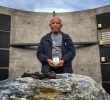By Germelina Lacorte
davaotoday.com
DAVAO CITY — For years now, the new generation of Moro tribes in Mindanao have been hearing about what happened in the Jabidah Massacre 38 years ago through songs sung to them even while in the cradle.
Evelyn Carias, 35, wasn�t born yet when over 28 Moro trainees, mostly Tausugs, were killed by the Marcos regime on March 18, 1968. But, she said, she heard about it from songs that her ompo (the K�lagan word for grandfather) used to sing to her as a child.
The 28 trainees were involved in Operation Merdeka, a plot that involved close to 200 Tausug and Samal Muslims, aged 18 to 30, from Sulu and Tawi-tawi. Merdeka was hatched by the Marcos regime to invade Sabah. (See related story.)
�Until now, justice for the victims and their families remain elusive,� said Herman Arindain, spokesperson of the Suara Bangsamoro, a Moro party-list group.
The Jabidah Massacre united diverse groups of Moro tribes in Mindanao and triggered the separatist movement led by Moro National Liberation Front (MNLF) Nur� Misuari. Stories about what happened seeped into the Moro communities so that what happened; the massacre had a way of �reaching them through songs and word of mouth.
�Jabidah had united the culturally diverse Muslim population in Mindanao, according to Arindain. “What happened to Jabidah should be connected to what happened to the MNLF to make us understand what�s happening now,� said Mira Yusef, a �Balik Islam� �Fulbright scholar now studying the Muslim domestic helpers in the Middle East.
In 1996, Misuari signed the peace process with former President Ramos. But the peace process he signed with the government was deemed a failure and he is now detained in Santa Rosa, Laguna, for the crime of rebellion.
�What we experienced as a people, we used to recount them in songs,� Arindain said, �We have several records of songs on what happened to our people way back to the Japanese occupation and the coming here of the Americans.�
�Like a hele (nursery rhyme), the song usually puts a child to sleep but in our case and in the case of Moro communities at that time, the hele contains a narrative of our people,� said Almira Lomondot, 21, spokesperson of the Liga ng mga Kabataang Moro.
Carias, who grew up in a Moro community in the Davao barangay of Mandug, said she already knew the song by heart when she was five years old. But she was already
in high school when she realized that what happened as told in the song was true.
Her ompo, now 70, was displaced out of Jolo because of the war. He settled somewhere in Davao del Sur but the conflict there forced him to move again, this time to Mandug. �He used to sing it to us in the cradle, but sometimes, we also hear these songs being sung while they were taking their afternoon rest from work in the farm,� said Carias. �He lived a life of displacement,� she added, �That�s why, he can relate to Jabidah.�
According to Yusef, �jabidah� was Malay word for a beautiful woman. (Germelina Lacorte/davaotoday.com)










